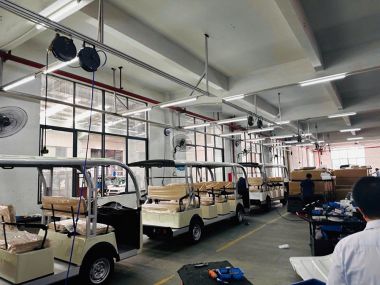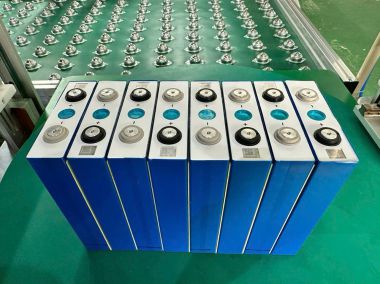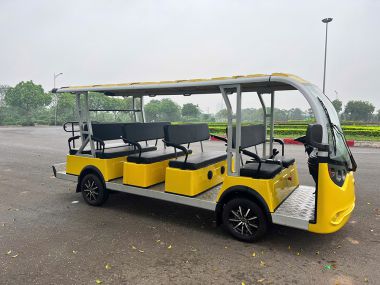Lithium Battery for Electric Vehicles: Optimized Technology for Performance and Durability
In recent years, the trend of using electric vehicles has rapidly spread, not only in public transportation and private vehicles but also in the tourism and leisure industry. Electric vehicles have become the ideal choice for sightseeing, relaxation, and even entertainment in public areas. Their convenience, environmental friendliness, and ability to provide an enjoyable experience have made electric vehicles increasingly popular. Let’s explore the 5 outstanding benefits that electric vehicles bring to modern tourism and leisure.
1. What is Lithium-ion Battery?
A Lithium-ion battery (commonly known as Lithium battery) is a type of rechargeable battery with a high energy storage capacity and is widely used in electronic devices, from smartphones to electric vehicles. Lithium batteries operate based on the mechanism of moving lithium ions from one electrode to another, which generates a current to power the device.

Lithium batteries for electric vehicles are typically made up of multiple small battery modules connected together to form a large battery system capable of providing energy for the vehicle’s movement. This technology stands out with its high energy storage capacity, long lifespan, and lighter weight compared to traditional batteries like lead-acid batteries.
2. Why is Lithium Battery the Optimal Choice for Electric Vehicles?
2.1. High Energy Efficiency
One of the biggest advantages of lithium batteries is their high energy efficiency. Lithium-ion batteries can store a large amount of energy in a compact size, allowing electric vehicles to travel longer distances on a full charge. This is especially important for electric vehicles, as users always want a longer range to avoid frequent recharging.

Compared to lead-acid batteries, lithium batteries have much higher energy conversion efficiency, optimizing energy use and minimizing losses during operation.
2.2. Lightweight
The weight of the battery is a crucial factor affecting the performance of electric vehicles. Lithium batteries are significantly lighter than traditional batteries, which helps reduce the overall weight of the vehicle, thereby increasing energy efficiency and improving performance.
A lighter electric vehicle will require less energy to move, thus increasing the driving range and improving acceleration and maneuverability.
2.3. High Lifespan and Durability
Lithium batteries have a long lifespan, typically ranging from 8 to 10 years, and can last even longer if properly maintained and used. Their ability to withstand many charge-discharge cycles without significantly losing capacity makes lithium batteries the optimal choice for electric vehicles.
Moreover, lithium batteries can withstand harsh environmental conditions, from high temperatures to freezing cold, allowing electric vehicles to operate stably in various regions and climates.
2.4. Fast Charging Time
Fast-charging technology is another major advantage of lithium batteries. While traditional batteries require hours to fully charge, lithium batteries can charge up to 80% capacity in just 30 to 60 minutes when using fast charging stations. This greatly benefits electric vehicle users, reducing waiting times and increasing flexibility when using the vehicle.
3. Types of Lithium Batteries for Electric Vehicles
There are two main types of lithium batteries used in electric vehicles today: Lithium-ion (Li-ion) and Lithium Iron Phosphate (LiFePO4).
-
Lithium-ion (Li-ion): This is the most common battery type, known for its high energy density, which helps electric vehicles travel further. Li-ion batteries are used in most electric vehicle models by Tesla, Nissan, and many other manufacturers.
-
Lithium Iron Phosphate (LiFePO4): This battery type has a longer lifespan and is safer compared to Li-ion batteries. Although it has a lower energy density, LiFePO4 batteries can withstand high temperatures and are less prone to fire hazards, making them ideal for electric vehicles that require durability and safety.
4. Challenges and Solutions for Lithium Batteries
4.1. High Cost
Despite its many advantages, lithium batteries are still quite expensive, accounting for a large portion of the cost of electric vehicles. However, with advancements in technology and increasing production scale, the cost of lithium batteries is gradually decreasing. Additionally, battery recycling is being researched and developed to optimize costs and reduce environmental impact.
4.2. Recycling Challenges
Recycling lithium batteries is an important issue to address, as the production and disposal of batteries can have a negative environmental impact. Currently, companies like Tesla and other research organizations are investing in battery recycling technologies to recover precious metals like Lithium, Nickel, and Cobalt, thus minimizing environmental impact and creating a sustainable lifecycle for batteries.
4.3. Dependence on Lithium Resources
Lithium is a critical material for battery production, and the supply of lithium is currently concentrated in countries such as Chile, Australia, and China. Dependence on these countries' resources could present geopolitical and economic challenges. However, research is underway to find alternative resources and develop new technologies to reduce reliance on lithium.
5. Recent Advances in Lithium Battery Technology
Lithium battery technology is constantly improving to enhance performance and reduce costs. Some research focuses on developing solid-state lithium batteries, which have higher energy density, greater safety, and faster charging times compared to traditional lithium-ion batteries. Solid-state battery technology is expected to help electric vehicles achieve longer ranges and shorter charging times, thereby improving user experience.
Additionally, materials like graphene are being explored to improve charging speeds and increase energy storage capacity. These advances are expected to make electric vehicles more widespread and better meet consumer needs.
6. Practical Applications of Lithium Batteries
6.1. Personal Electric Vehicles
Major electric vehicle manufacturers like Tesla, Nissan, and BMW use lithium batteries in their vehicle lines. Lithium batteries enable vehicles to travel long distances, from 300 to 500 km on a single charge, providing convenience and flexibility for users.
6.2. Public Electric Vehicles
In addition to personal vehicles, lithium batteries are also used in electric buses and other public transportation vehicles. Major cities around the world are gradually transitioning to electric buses to reduce pollution and noise, thereby improving the quality of urban life.
7. The Future of Lithium Battery Technology
Lithium batteries are expected to continue playing a vital role in the future of the transportation industry. With ongoing advancements in manufacturing technology and recycling solutions, lithium batteries will become more efficient and environmentally friendly.
Additionally, the combination of battery technology with renewable energy sources like solar and wind power is creating a sustainable transportation ecosystem, where electric vehicles can be fully charged using green energy sources, minimizing greenhouse gas emissions.
Lithium batteries are the driving force behind the development of modern electric vehicles, offering outstanding advantages in terms of performance, durability, and fast charging. Although there are some challenges related to cost and recycling, with advancements in technology and production scale, lithium batteries are gradually becoming the optimal choice for the future of transportation.
Electric vehicles are not just a trend but also an important step toward a greener and more sustainable world. With the development of lithium battery technology and new innovations, we can expect a future where electric vehicles become the predominant means of transportation, offering convenience and environmental friendliness for everyone.




